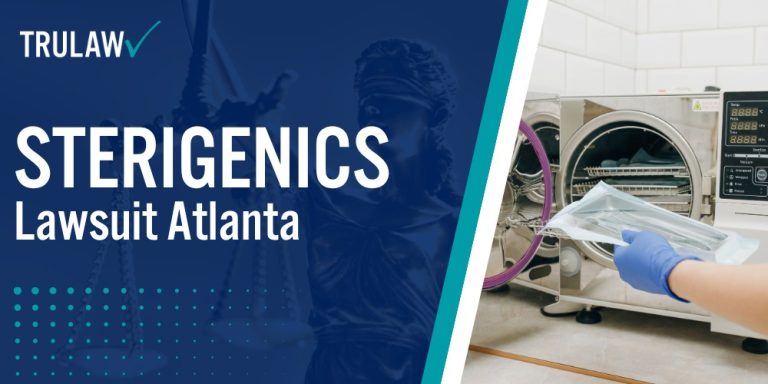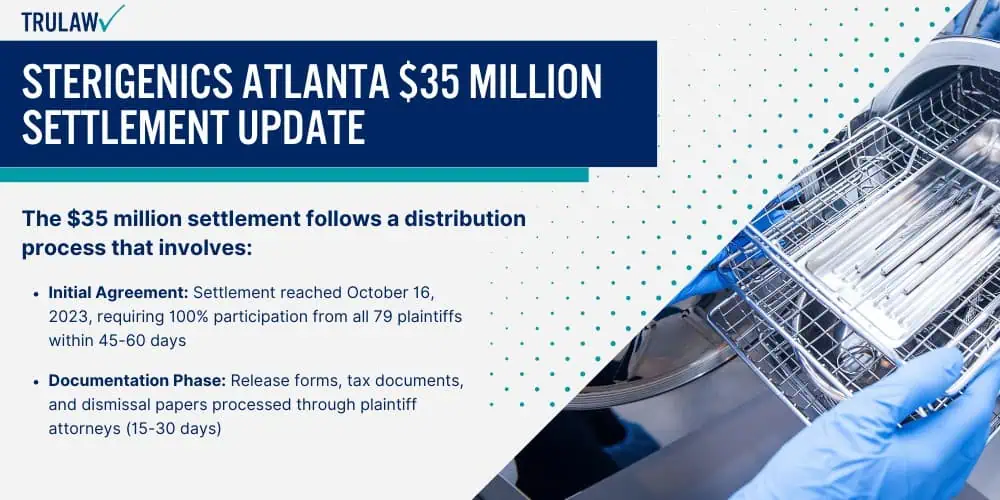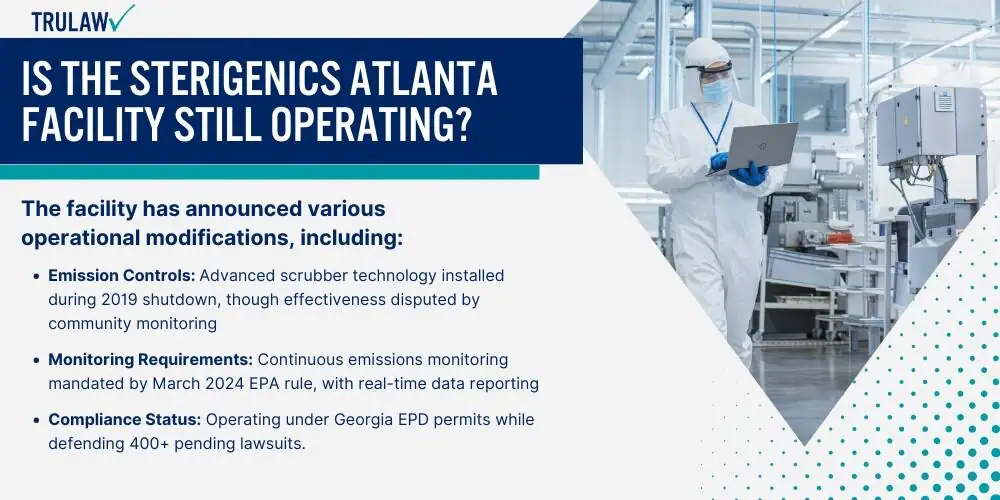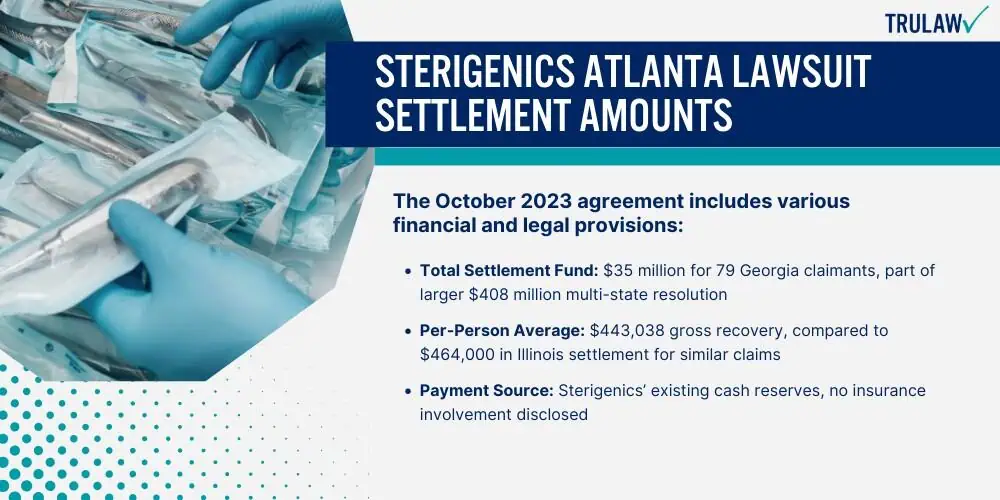With over 400 lawsuits still pending and a landmark $70 million verdict in neighboring Covington, the pathway to compensation for ethylene oxide exposure continues evolving as new scientific evidence and legal precedents emerge.
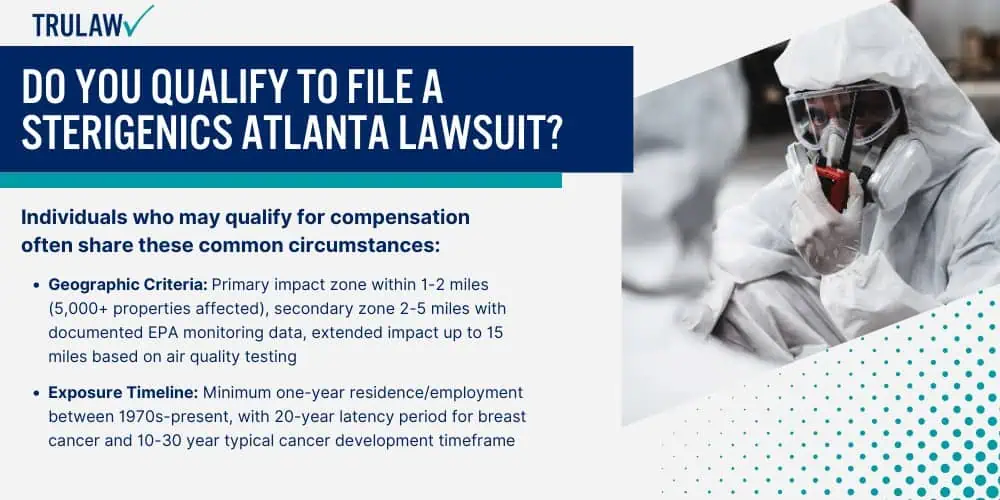
While Sterigenics reached a $35 million settlement in October 2023 resolving 79 cases, opportunities remain for those not included in that agreement, with approximately 400 claims still pending against the company and its parent company Sotera.
Eligibility Requirements for New Claims
EPA monitoring data now confirms what residents have long suspected—cancer risks extend far beyond the facility’s immediate vicinity, with elevated ethylene oxide levels detected up to 3.5 miles away and property impacts documented within a 2-mile radius affecting 5,000 homes.
The Environmental Protection Agency classifies ethylene oxide as a known human carcinogen, establishing the scientific foundation for these claims.
Individuals who may qualify for compensation often share these common circumstances:
- Geographic Criteria: Primary impact zone within 1-2 miles (5,000+ properties affected), secondary zone 2-5 miles with documented EPA monitoring data, extended impact up to 15 miles based on air quality testing
- Exposure Timeline: Minimum one-year residence/employment between 1970s-present, with 20-year latency period for breast cancer and 10-30 year typical cancer development timeframe
- Medical Diagnoses: EPA-confirmed cancers include lymphocytic leukemia, breast cancer, non-Hodgkin lymphoma, and myeloma, with increased risks documented in 2016 assessment showing 60x higher cancer potency than previously estimated
- Legal Timeframe: Georgia’s 2-year statute of limitations from diagnosis or discovery, with March 2026 trial date set for pending Cobb County cases
Time remains a factor in pursuing these claims, as Georgia’s statute of limitations for personal injury cases typically allows two years from the date of diagnosis or discovery of the connection between exposure and illness.
Given the latency period between ethylene oxide exposure and cancer development, which can span decades, determining the appropriate filing deadline requires careful legal analysis.
Gathering Evidence for an Ethylene Oxide Exposure Claim
Building a strong environmental litigation case requires meticulous documentation (from decades-old utility bills to cutting-edge air monitoring data), as plaintiffs work to establish the invisible thread connecting corporate emissions to devastating personal health outcomes.
EPA data showing elevated cancer risks in communities surrounding the Sterigenics facility serves as powerful supporting evidence for individual claims.
Various forms of documentation can strengthen an ethylene oxide exposure claim:
- Residential Documentation: Property deeds, rental agreements, or utility bills proving residence within EPA-identified census tracts showing 100+ cancer risk per million
- Medical Records: Complete pathology reports, treatment history, and physician statements linking cancer to environmental exposure, particularly for cancers with documented EtO association
- Employment Verification: W-2s, pay stubs, or HR records for facility workers or nearby employees, with emphasis on duration and proximity to sterilization operations
- Environmental Data: EPA monitoring showing levels from 0.21 to 3.6 micrograms per cubic meter, Georgia EPD reports, and air quality test results from 2019-2025
- Property Impact: Cobb County tax assessments showing 10% devaluation for properties within 2-mile radius as of May 2020
The EPA’s own risk assessments have identified the area surrounding the Smyrna Sterigenics plant as having elevated cancer risks due to ethylene oxide emissions.
This regulatory acknowledgment, combined with air monitoring results showing emission levels far exceeding acceptable limits, strengthens the foundation for individual exposure claims and helps establish the connection between facility operations and community health impacts.
Damages in Ethylene Oxide Exposure Lawsuits
Recent verdicts demonstrate that juries increasingly recognize the true cost of corporate environmental negligence, awarding compensation that reflects not just medical bills but the entirety of what victims lose when preventable toxic exposure upends their lives.
Georgia law recognizes both economic and non-economic damages in toxic exposure cases, allowing plaintiffs to seek fair compensation for past and future losses, including lost wages from their inability to work during treatment.
Compensation in ethylene oxide cases may address various types of losses, such as:
- Medical Expenses – Surgery, chemotherapy, radiation averaging $50,000-$500,000+ based on cancer type and stage, with ongoing monitoring costs of $5,000-$15,000 annually
- Lost Earnings – Average wage loss calculations based on Georgia median income ($65,030), with total disability cases potentially exceeding $2 million over working lifetime
- Pain & Suffering – Non-economic damages typically 2-3x economic damages in Georgia toxic tort cases, subject to case-specific factors
- Property Devaluation – Documented 10% reduction by Cobb County Board of Tax Assessors affecting 5,000 properties, average loss $30,000-$50,000 per property
- Wrongful Death – Georgia statutory damages plus full value of life, with recent verdicts like the $70 million Gary Walker case in May 2025
- Medical Monitoring – Future cancer screening costs estimated at $2,000-$5,000 annually for high-risk individuals exposed
Settlement amounts in ethylene oxide exposure cases vary based on factors including cancer type, stage at diagnosis, age of the victim, and extent of treatment required.
The October 2023 settlement averaging approximately $443,000 per claimant provides a baseline reference, though individual cases may result in higher or lower compensation depending on specific circumstances and the strength of causation evidence.
If you or a loved one lived or worked near the Smyrna Sterigenics facility and developed cancer after exposure to ethylene oxide emissions, you may be eligible to seek compensation.
Contact TruLaw using the chat on this page to receive an instant case evaluation and determine whether you qualify to join others in filing an Ethylene Oxide Lawsuit today.
